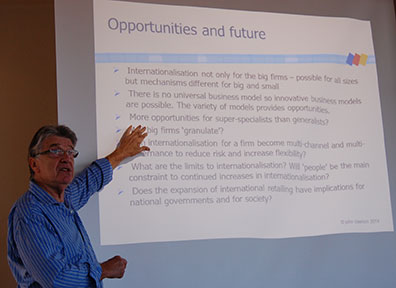- Hem
- Aktuellt
- Hitta nyheter
- Some trends and myths in international retailing - rapport från Centre for Retailings 10:e frukostworkshop
Some trends and myths in international retailing - rapport från Centre for Retailings 10:e frukostworkshop
På Centre for Retailings 10:e frukostworkshop samlades ett 30-tal personer verksamma inom handel och akademi för att höra professor John Dawson från University of Edinburgh prata om trender och myter inom international retailing.
Här kommer ett sammandrag av John Dawsons föredrag:
Professor Dawson began with giving an overview of the international retailers of today. There are a very large number of international retailers that we don’t appreciate as international. Camper is one example. It is from a small town in Mallorca, but is now spread across all continents. Walmart is a very different sort of operation. Enormous amounts of stock and enormous amounts of inventory whereas Camper has almost no inventory. There are also international e-retailers for example Amazon (bigger) and Zalando (smaller). The 100 biggest retailers now account for about a third of all retail sales around the world.
3 trends
1. Increased scale of activity
Retailing is very much an exporting industry, exporting its ideas and its knowledge and often repatriating the profits back to the home country. The scale that we can define as international has grown and is growing very rapidly. Zara, Walmart and other big businesses are focusing on getting into big markets such as India, China. They have to build the volume to keep their business model working.
2. Increase in scope and reach
Big firms are increasing their business by more formats and more types of location. We think of Walmart as the big Walmart stores, but the reality is that Walmart operate a lot of different brands supermarkets, cash and carry, restaurants. Walmart is not so much going into new countries but developing new formats, new types of retailing. For example a format for Walmart on campus that sells all the things the student wants.
Medium-sized firms are driving the scope and the spread. For example Ted Baker – a slightly quirky clothing company. They have several stores in international cities, but each store is different. Each store takes a particular theme and develops it in that country.
Smallish firms for example food companies such as Eataly, a firm that sells Italian gourmet food, only has 30 stores, 15 in Italy and 15 elsewhere. These companies have found a way to extending their reach without having to be enormous.
The small and medium-sized firms are much more willing to experiment and this allows them to expand their scope and reach.
3. More variety of international business models
Many different business models are used within all branches. Some use multiple methods to access the markets in a single country. It can be different methods of governance, franchising, buyer groups and licensing. There are also lots of different forms of controlling and governing this expansion of scope. That is partly because of government policies in different countries. And partly because retailers are moving in to high-risk markets into the Middle Eastern markets so that generates a variety of responses, and a variety of channels, formulas, formats etc.
To sum up, international retailing is here to stay. The international retailers’ control of the global retail system is going to increase. The spread and scope of international retailing is going to expand considerably. And the ways that it is going to appear are going to increase.
Myths
Only for big firms with good solid base in their home market
That is not the case anymore. The rules have changed. For example Cath Kidston has a weak home market, but is successful in the international market. Another example is Zalando that went international within a year of being created as a business.
Standardization
All you need is a good model you can pick up and put it in another country and it will work. Now, it is seen as more about adjusting to local markets because it is different everywhere.
Strong brands
A strong brand was the vehicle on which you went and that was all you needed. That is not seen as enough anymore. You need to edit the brand so you still have the core, but the brand becomes localized.
E-commerce gives global access
If you have a transactional website you have access to global markets. However, in some countries you are not allowed to sell some items, in some countries governments restrict access to your website. So it is not as simple as “I have a transactional website now I can serve the world”
Opportunities for the future

- Not only for big firms, but also for small firms with 5-10 shops.
- Probably more opportunities for specialists or superspecialists. For example Camper, a particular style, a particular shoe, a particular style tradition.
- Are there some limits that put a ceiling to the growth? People, will employees be willing to move around to other countries? This might be a possible constraint.
- Will governments start to wake up and realize that the local society is essentially taken over by organizations from other countries. For example Poland is dominated by foreign retailers, is that good?